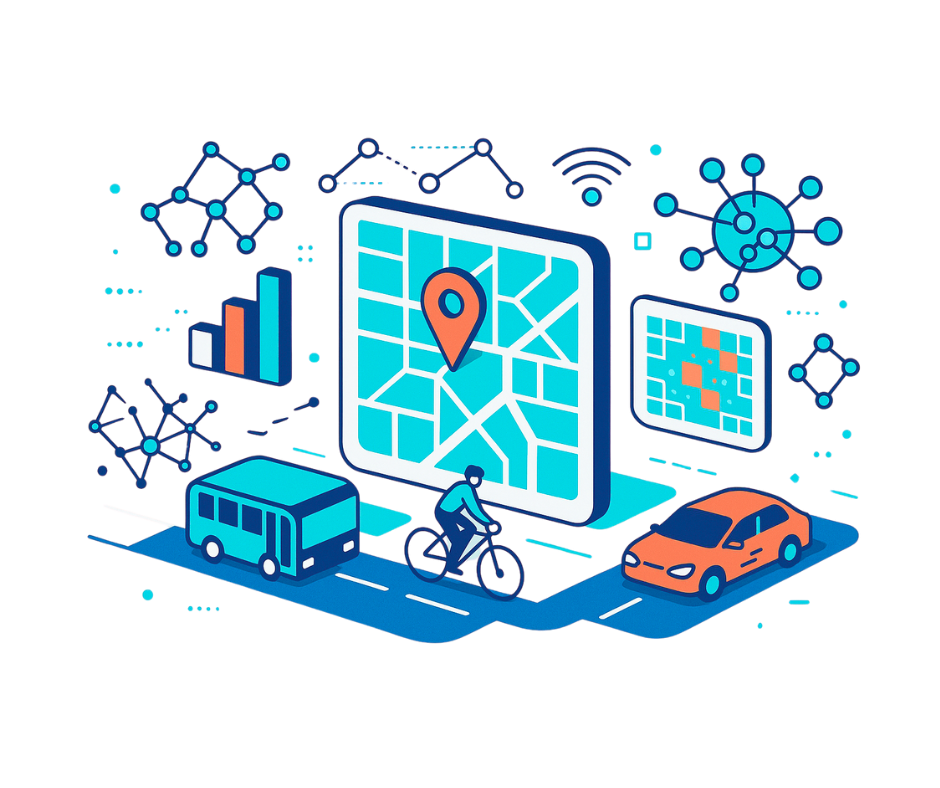AIM4Mobility: Tools and Techniques for Geospatial ML


Urban mobility is evolving and so are the tools to manage it.
Training Format
Self-paced course.
Duration
8 hours (considering theoretical and practical tasks)
Language
English
Certificate of completion
Upon course compeltion, each participant will recieve a diploma from the EIT Urban Mobility.
Who is AIM4Mobility addressed to?



What will the participants get from the course
Apply
data science techniques to work on real-world urban mobility challenges.
Integrate
OpenStreetMap (OSM) and other open geospatial data sources to enhance mobility analyzes and applications.
Process and analyse
geospatial datasets using Python and machine learning libraries.
Understand
spatial clustering and geospatial machine learning methods for identifying mobility patterns and urban analysis.
Use
spatial data visualization techniques to communicate mobility insights and trends effectively.
MODULES
FUNDATIONS of URBAN MOBILITY
Introduction
In this module, you'll explore the key challenges facing modern cities, including congestion, safety concerns, and aging infrastructure. You'll learn why data-driven solutions are essential for improving urban mobility and building smarter, more efficient transport systems.
Through real-world examples and reflective activity, you'll analyse common mobility pain points and discover how data science can support solutions like accident reduction, route optimization, and enhanced public transit.
A final assessment will review all topics covered in the course.
Through real-world examples and reflective activity, you'll analyse common mobility pain points and discover how data science can support solutions like accident reduction, route optimization, and enhanced public transit.
A final assessment will review all topics covered in the course.
MOBILITY DATA SOURCES & OPEN DATA Module 1
In this module, you'll learn about essential mobility data sources, including traffic sensors, accident databases, ridership statistics, and city open data platforms. Special focus is given to OpenStreetMap (OSM), where you'll explore its structure—such as roads, transit stops, and points of interest—and consider its role in mobility analysis through an interactive activity.
The module highlights how these diverse data sources contribute to a comprehensive understanding of urban mobility.
A final assessment wraps up the topics and sets the stage for the next module on geospatial data foundations.
The module highlights how these diverse data sources contribute to a comprehensive understanding of urban mobility.
A final assessment wraps up the topics and sets the stage for the next module on geospatial data foundations.
GEOSPATIAN DATA FOUNDATIONS
Module 2
In this module, you'll be introduced to key Python libraries for geospatial analysis, including GeoPandas and OSMnx. You'll learn how to load, explore, and manipulate geospatial datasets—such as shapefiles and coordinate systems—using GeoPandas.
The module also demonstrates how to integrate OpenStreetMap (OSM) road network data with accident datasets to support mobility analysis. By the end, you'll have a solid foundation in handling spatial data for urban mobility projects.
A final assessment will reinforce the concepts before you move on to data preparation and exploratory analysis.
The module also demonstrates how to integrate OpenStreetMap (OSM) road network data with accident datasets to support mobility analysis. By the end, you'll have a solid foundation in handling spatial data for urban mobility projects.
A final assessment will reinforce the concepts before you move on to data preparation and exploratory analysis.
DATA PRERATION & EDA
Module 3
In this module, you'll learn essential techniques for cleaning mobility datasets and performing exploratory data analysis (EDA). Topics include handling missing values, detecting outliers, and engineering meaningful features such as traffic volumes and distances to intersections.
You'll also practice cleaning and visualizing real-world mobility data to uncover trends and generate actionable insights.
A final assessment will help solidify your understanding before moving on to data visualization.
You'll also practice cleaning and visualizing real-world mobility data to uncover trends and generate actionable insights.
A final assessment will help solidify your understanding before moving on to data visualization.
VISUALIZING URBAN MOBILITY
Module 4
In this module, you'll learn how to create compelling visualizations to communicate mobility trends using interactive mapping tools.
You'll explore the basics of Folium, including how to add markers, polygons, and cluster accident data. You'll also generate choropleth maps to reveal spatial patterns in accident frequency and traffic flow. These visualization techniques will help you better interpret and present mobility insights.
A final assessment wraps up the module and sets the stage for spatial analysis.
You'll explore the basics of Folium, including how to add markers, polygons, and cluster accident data. You'll also generate choropleth maps to reveal spatial patterns in accident frequency and traffic flow. These visualization techniques will help you better interpret and present mobility insights.
A final assessment wraps up the module and sets the stage for spatial analysis.
SPATIAL ANALYSIS
Module 5
In this module, you'll explore clustering techniques such as DBSCAN and K-Means to detect mobility and accident hotspots.
You'll apply DBSCAN to identify high-risk areas and analyse spatial patterns in urban mobility. These techniques provide powerful tools for uncovering hidden trends in geospatial data.
A final assessment reinforces your learning before diving into hands-on accident analysis.
You'll apply DBSCAN to identify high-risk areas and analyse spatial patterns in urban mobility. These techniques provide powerful tools for uncovering hidden trends in geospatial data.
A final assessment reinforces your learning before diving into hands-on accident analysis.
HANDS-ON: ROAD ACCIDENT ANALYTICS
Module 6
In this module, you'll apply analytical and visualization techniques to real-world road accident data, helping to inform safer urban planning.
You'll explore accident patterns by severity, frequency, and temporal trends, and learn to create heatmaps and visual dashboards using tools like GeoPandas, Folium, and Seaborn. These hands-on skills prepare you for building interactive applications.
The module concludes with an assessment and a preview of dashboard deployment.
You'll explore accident patterns by severity, frequency, and temporal trends, and learn to create heatmaps and visual dashboards using tools like GeoPandas, Folium, and Seaborn. These hands-on skills prepare you for building interactive applications.
The module concludes with an assessment and a preview of dashboard deployment.
DEPLOYING A DASHBOARD
Module 7
In this module, you'll learn how to build and deploy interactive dashboards for mobility data using Streamlit.
You'll set up a basic Streamlit app and enhance it with text, images, charts, and embedded Folium maps. These skills will help you create user-friendly tools to communicate data insights effectively. The module wraps up with a summary of key techniques and a look ahead to ethical considerations in AI for mobility.
You'll set up a basic Streamlit app and enhance it with text, images, charts, and embedded Folium maps. These skills will help you create user-friendly tools to communicate data insights effectively. The module wraps up with a summary of key techniques and a look ahead to ethical considerations in AI for mobility.
AIM4Mobility is made up for 4 courses
Tools and Techniques for Geospatial ML
This course teaches geospatial data analysis with Python to tackle urban mobility challenges, using OSM data and spatial tools.
Fundamental Trends of AI & ML
The couse covers applications like demand forecasting, traffic optimisation, and autonomous vehicles, as well as key tools, challenges, and ethical issues.
Predictive Modeling and Demand Forecasting
This course teaches how to build and apply predictive models in urban mobility using AI and ML.
AI Challenges & Ethical Considerations
Introduction to ethical principles for AI in urban mobility, covering oversight, accountability, data governance, and fairness.
This project is supported by EIT Urban Mobility, an initiative of the European Institute of Innovation and Technology (EIT), a body of the European Union. EIT Urban Mobility acts to accelerate positive change on mobility to make urban spaces more liveable. Learn more: eiturbanmobility.eu


